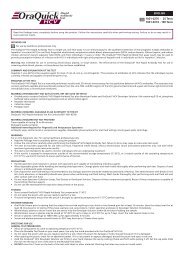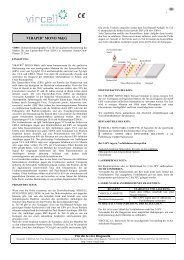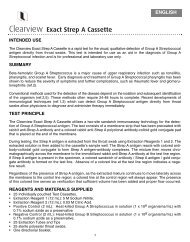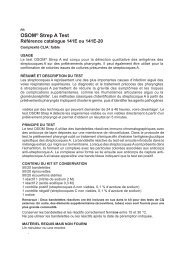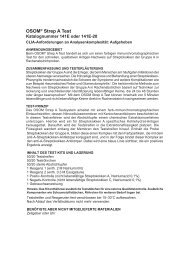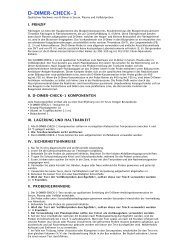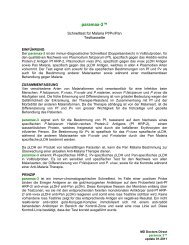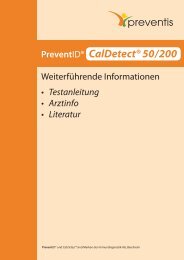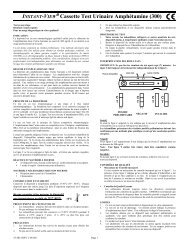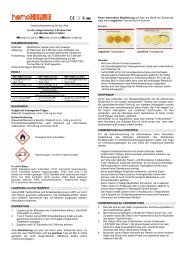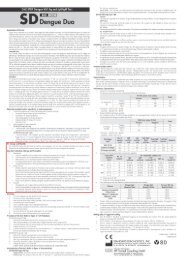Mono Test - MD Doctors Direct
Mono Test - MD Doctors Direct
Mono Test - MD Doctors Direct
Create successful ePaper yourself
Turn your PDF publications into a flip-book with our unique Google optimized e-Paper software.
®<br />
<strong>Mono</strong> <strong>Test</strong><br />
1<br />
2<br />
1 DROP 1 DROP<br />
For serum,<br />
plasma or<br />
whole blood<br />
samples<br />
in tubes:<br />
For fi ngertip<br />
blood:<br />
3 4<br />
5 min<br />
®<br />
POSITIVE<br />
NEGATIVE<br />
Rev. 3078-0, 06/11
®<br />
<strong>Mono</strong> <strong>Test</strong><br />
CLIA Complexity: Waived for Whole Blood<br />
Non-Waived for Serum or Plasma<br />
FOR LABORATORY AND PROFESSIONAL IN VITRO DIAGNOSTIC USE ONLY.<br />
INTENDED USE<br />
The OSOM ® <strong>Mono</strong> <strong>Test</strong> is intended for the qualitative detection of infectious mononucleosis heterophile<br />
antibodies in serum, plasma or whole blood as an aid in the diagnosis of infectious mononucleosis.<br />
SUMMARY AND EXPLANATION OF TEST<br />
The diagnosis of infectious mononucleosis (IM) is suggested on the basis of the clinical symptoms of<br />
fever, sore throat and swollen lymph glands. The highest incidence of symptomatic IM occurs during late<br />
adolescence (15 – 24 years of age). Infectious mononucleosis is caused by the Epstein-Barr Virus (EBV). (1,2)<br />
The laboratory diagnosis of IM is based on the detection of IM heterophile antibodies. These heterophile<br />
antibodies are directed against antigens found in bovine, sheep and horse erythrocytes. The OSOM<br />
<strong>Mono</strong> <strong>Test</strong> utilizes an extract of bovine erythrocytes to give the required sensitivity and specifi city.<br />
PRINCIPLES OF TEST<br />
The OSOM <strong>Mono</strong> <strong>Test</strong> uses color immunochromatographic dipstick technology with bovine erythrocyte<br />
extract coated on the membrane. In the test procedure, serum, plasma or whole blood is mixed with<br />
the Diluent. Then the <strong>Test</strong> Stick is placed in the mixture and the mixture migrates along the membrane.<br />
If the specifi c IM heterophile antibody is present in the sample, it will form a complex with the bovine<br />
erythrocyte extract conjugated color particles. The complex will then be bound by bovine erythrocyte<br />
extract immobilized on the membrane and a visible blue <strong>Test</strong> Line will appear to indicate a positive result.<br />
KIT CONTENTS AND STORAGE<br />
25 <strong>Test</strong> Sticks in a container<br />
25 <strong>Test</strong> Tubes<br />
25 Transfer Pipettes<br />
25 Capillary Tubes with 1 Capillary Bulb<br />
1 Diluent (contains buffer with 0.2% sodium azide)<br />
1 <strong>Mono</strong> Positive Control (contains rabbit anti-beef stroma in tris buffer with 0.2% sodium azide and<br />
0.05% gentamycin sulfate preservatives)<br />
1 <strong>Mono</strong> Negative Control (contains goat albumin in tris buffer with 0.2% sodium azide)<br />
1 Work Station<br />
1 <strong>Direct</strong>ional Insert<br />
2 Additional test sticks have been included in the kit for external QC testing<br />
Note: Extra components (tubes, pipettes, capillary tubes and capillary bulb) have been provided for<br />
your convenience.<br />
Store the <strong>Test</strong> Sticks and reagents tightly capped at 15° – 30°C (59°– 86°F).<br />
Do not use the <strong>Test</strong> Sticks or reagents after their expiration dates.<br />
MATERIALS REQUIRED BUT NOT PROVIDED<br />
Specimen collection containers.<br />
A timer or watch.<br />
PRECAUTIONS<br />
• For in-vitro diagnostic use only.<br />
• Follow your laboratory safety guidelines in the collection, handling, storage and disposal of patient<br />
specimens and all items exposed to patient specimens.<br />
• The Diluent and Controls contain sodium azide which may react with lead or copper plumbing to form<br />
potentially explosive metal azide. Large quantities of water must be used to fl ush discarded Diluent or<br />
Controls down a sink.<br />
• The Capillary Bulb contains dry natural rubber.<br />
• Do not interchange or mix components from different kit lots.<br />
SPECIMEN COLLECTION AND PREPARATION<br />
Serum, Plasma, or Whole Blood Sample<br />
Obtain specimens by acceptable medical technique. Collect whole blood samples using a tube<br />
containing EDTA or heparin as an anticoagulant. Other anticoagulants have not been tested. Serum<br />
and plasma specimens may be refrigerated (2°– 8°C; 36° – 46°F) and tested within 48 hours; serum<br />
and plasma specimens held for longer times should be frozen (below -10°C; 14°F) and tested within<br />
3 months. <strong>Test</strong> whole blood specimens within 24 hours. Specimens must be at room temperature<br />
(15°– 30°C; 59° – 86°F) when tested.<br />
Fingertip Whole Blood<br />
Hold the capillary tube horizontally while collecting the sample. Touch the end of the capillary tube to<br />
the drop of blood on the patient’s fi nger. Fill the capillary tube completely. Place the small end of the<br />
black bulb onto the capillary tube. Place your fi ngertip over the opening in the bulb. Squeeze the bulb<br />
to dispense the whole blood sample into the test tube.
QUALITY CONTROL<br />
External Quality Control<br />
For external QC testing, use the controls provided in the kit. Add one free falling drop of control<br />
to the <strong>Test</strong> Tube and then proceed in the same manner as with a patient sample. Quality Control<br />
requirements should be established in accordance with local, state and federal regulations or<br />
accreditation requirements. Minimally, Sekisui Diagnostics recommends that positive and negative<br />
external controls be run with each new lot and with each new untrained operator. Some commercial<br />
controls may contain interfering additives. The use of these controls is not recommended.<br />
Internal Quality Controls<br />
The OSOM <strong>Mono</strong> <strong>Test</strong> provides two levels of internal procedural controls with each test procedure.<br />
• The red Control Line is an internal positive procedural control. The <strong>Test</strong> Stick must absorb the proper<br />
amount of test material and be working properly for the red Control Line to appear.<br />
• A clear background is an internal negative procedural control. If the test has been performed<br />
correctly and the <strong>Test</strong> Stick is working properly, the background will clear to give a discernible result.<br />
If the red Control Line does not appear, the test may be invalid. If the background does not clear and<br />
interferes with the test result, the test may be invalid. Call Sekisui Diagnostics Technical Assistance if you<br />
experience either of these problems.<br />
LIMITATIONS<br />
• As with all diagnostic assays, the results obtained by this test yield data that must be used as an<br />
adjunct to other information available to the physician.<br />
• The OSOM <strong>Mono</strong> <strong>Test</strong> is a qualitative test for the detection of IM heterophile antibody.<br />
• A negative result may be obtained from patients at the onset of the disease due to heterophile<br />
antibody levels below the sensitivity of this test kit. If symptoms persist or intensify, the test should<br />
be repeated.<br />
• Some segments of the population with acute IM are heterophile antibody negative. (1)<br />
EXPECTED VALUES<br />
A heterophile antibody response is observed in approximately 80 – 90% of adults and children with<br />
EBV-caused IM. This percentage drops to approximately 50% for children under four years of age. (1)<br />
While the incidence of IM refl ects wide seasonal, ethnic and geographical variation, a large<br />
epidemiological study noted that the highest incidence of symptomatic IM occurred during late<br />
adolescence (15 – 24 years of age) (2) .<br />
PERFORMANCE CHARACTERISTICS<br />
A total of 439 specimens (183 serum, 176 plasma and 80 whole blood) were evaluated by two clinical<br />
labs in a clinical study. <strong>Test</strong> results of the OSOM <strong>Mono</strong> <strong>Test</strong> were compared to results obtained with a<br />
commercially available latex particle agglutination test for the qualitative determination of infectious<br />
mononucleosis heterophile antibodies. Discrepancies between the results given by the OSOM <strong>Mono</strong><br />
<strong>Test</strong> and the latex particle agglutination test were resolved by Epstein-Barr Virus (EBV) specifi c serological<br />
assays. In these assays, the specifi c antibodies to the EBV capsid antigen (IgM) and EBV nuclear<br />
antigen-1 (IgM and IgG) were determined.<br />
Serum Specimens:<br />
Whole Blood Specimens:<br />
Comparative <strong>Test</strong><br />
Comparative <strong>Test</strong><br />
+ –<br />
+ –<br />
+ 74 8*<br />
+ 30 3*<br />
OSOM ® <strong>Mono</strong> <strong>Test</strong><br />
– 0 101<br />
OSOM ® <strong>Mono</strong> <strong>Test</strong><br />
– 0 47<br />
*6 out of 8 tested postitive by EBV testing *1 out of 3 tested postitive by EBV testing<br />
Plasma Specimens:<br />
Comparative <strong>Test</strong><br />
+ –<br />
+ 67 15*<br />
OSOM ® <strong>Mono</strong> <strong>Test</strong><br />
– 0 94<br />
*8 out of 15 tested postitive by EBV testing<br />
All Specimens:<br />
Comparative <strong>Test</strong><br />
+ –<br />
+ 171 26*<br />
OSOM ® <strong>Mono</strong> <strong>Test</strong><br />
– 0 242<br />
*15 out of 26 tested postitive by EBV testing<br />
When compared to a commercially available latex particle agglutination test for infectious mononucleosis<br />
heterophile antibodies, the OSOM <strong>Mono</strong> <strong>Test</strong> showed a sensitivity of 100% and a specifi city<br />
of 90.3%. The overall agreement was 94.1%.<br />
Fifteen of the 26 discrepant samples were determined to be recent or acute EBV infections by EBV<br />
serological testing, in which case the sample was considered positive. Including the samples confi rmed<br />
positive by EBV serological testing, the overall clinical study specifi city of the OSOM <strong>Mono</strong> <strong>Test</strong> is 95.9%<br />
and the overall sensitivity is 100%.<br />
POL Studies<br />
An evaluation of the OSOM <strong>Mono</strong> <strong>Test</strong> was conducted at three physicians’ offi ces or clinical laboratories<br />
where testing was performed by personnel with diverse educational backgrounds. Each site tested the<br />
randomly coded panel consisting of negative (5), low positive (3) and moderate positive (4) specimens<br />
for three days. The results obtained had 99.1% agreement (107/108) with the expected results.
TEST PROCEDURE<br />
Absorbent End Result Window Handle End<br />
STEP 1<br />
Addition of Specimen<br />
For serum, plasma, or whole blood samples in tubes:<br />
Use the Transfer Pipette provided<br />
and add one drop to the <strong>Test</strong> Tube.<br />
For fi ngertip blood:<br />
After fi lling a capillary tube end to end,<br />
dispense all of the blood into the <strong>Test</strong> Tube.<br />
STEP 2<br />
Slowly add 1 drop of Diluent to the bottom<br />
of the <strong>Test</strong> Tube.<br />
Mix.<br />
STEP 3<br />
Remove the <strong>Test</strong> Stick(s) from the container.<br />
Re-cap the container immediately.<br />
Place the Absorbent End of the <strong>Test</strong> Stick into the treated sample.<br />
Leave the <strong>Test</strong> Stick in the <strong>Test</strong> Tube.<br />
5 min<br />
STEP 4<br />
Read results at 5 minutes. Positive results may be read as soon as<br />
the red Control Line appears.<br />
REFERENCES<br />
1. Lennette, E.T., Epstein-Barr Virus, in Manual of Clinical Microbiology. Balows, A., Hausler,<br />
W.J. Jr., Herrmann, K.L., Isenberg, H.D., Shadomy, H.J., Editors, 5th Edition, American Society<br />
for Microbiology, Washington D.C., pp 847 – 852, 1991.<br />
2. Heath, C.W. Jr., Brodsky, A.L., Potolsky, A.l., Infectious <strong>Mono</strong>nucleosis in a General Population.<br />
Am. J. Epidemiol., 95:46, 1972.<br />
ASSISTANCE<br />
For technical assistance, call Sekisui Diagnostics<br />
Technical Assistance at (800) 332-1042.<br />
MANUFACTURED BY<br />
Sekisui Diagnostics, LLC<br />
6659 Top Gun Street<br />
San Diego, CA 92121 USA<br />
RE-ORDER<br />
No.145 (25 <strong>Test</strong>s)<br />
OSOM ® and the QC Inside logo are registered<br />
trademarks of Sekisui Diagnostics, LLC.<br />
Licensed under U.S. Patent Nos. 5,714,389;<br />
5,989,921 and 6,485,982 and related non-U.S.<br />
patents and patent applications.
INTERPRETATION OF TEST RESULTS<br />
Positive<br />
A blue <strong>Test</strong> Line and a red Control Line is a positive result for the detection of infectious mononucleosis<br />
heterophile antibody.<br />
Note that the blue line can be any shade of blue and can be lighter or darker than the line in the picture.<br />
Negative<br />
A red Control Line but no blue <strong>Test</strong> Line is a negative result. No infectious mononucleosis heterophile<br />
antibody has been detected.<br />
Invalid<br />
If after 5 minutes, no red Control Line appears or background color makes reading the red Control Line<br />
impossible, the result is invalid. If this occurs, repeat the test on a new <strong>Test</strong> Stick or call Sekisui Diagnostics<br />
Technical Assistance.<br />
Notes<br />
A blue or red line which appears uneven in color density is considered a valid result.<br />
Framingham, MA 01701<br />
Tel: 800-332-1042<br />
www.sekisuidiagnostics.com<br />
© 2011 Sekisui Diagnostics, LLC – All rights reserved.
KEY TO COMPONENT LABELING<br />
Use by YYYY-MM<br />
Batch code<br />
Catalog number<br />
Contents suffi cient for tests<br />
In vitro diagnostic medical device<br />
Temperature limitation<br />
Manufacturer/Manufactured by<br />
Consult instructions for use<br />
Authorized representative<br />
in the European Community<br />
Caution, consult accompanying<br />
documents.




